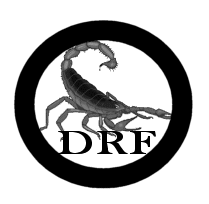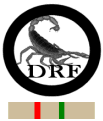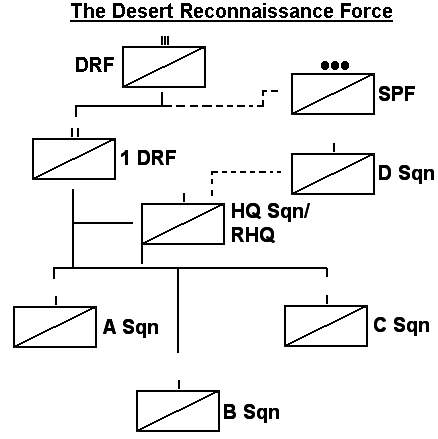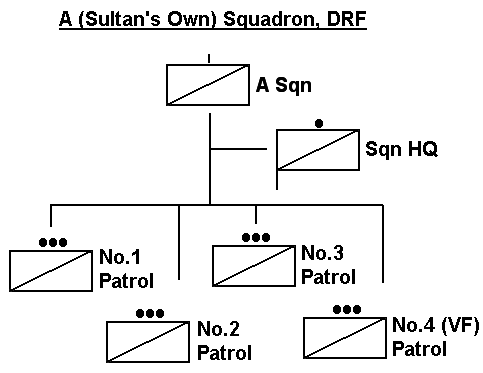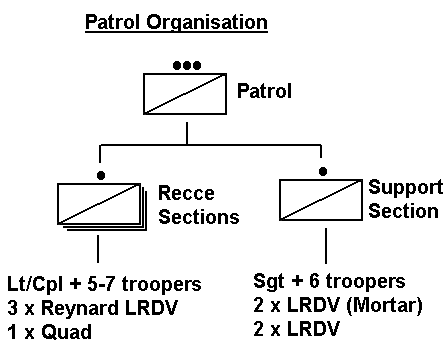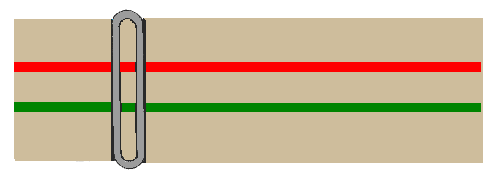Wellon Army: 2300AD
The Desert Reconnaissance Force Introduction The Desert Reconnaissance Force (DRF) is Wellon's specialist desert warfare unit which has mastered the art of operating in the depths of the harsh Blight region. Although largely used to train other parts of the Wellon Army and its British allies in desert warfare it also has its own operational sub-units and special formations. The DRF was only formally created in 2285, however it has its roots in several paramilitary units some of which reach back over 300 years and to Earth. Today, one squadron of the DRF is deploying to Crater on the French Arm. Narrative Corporal John al-Masirah was a patient man, he'd learnt to be. He waited whilst the remorseless sunlight battered down on him under the sun cape. He kept his eye to the screen of the M/RSU, slowly scanning the pass from where he expected the enemy to come, blinking away the sweat. The M/RSU was tied into two Green Hunter tubes, concealed and remoted out from his position. Even in his desert rig the heat was almost unbearable, his thirst sated only by small sips of water every hour or so. He had not be a patient man in his youth; a violent man, a thief and a defiler of women. He spent time in a variety of prisons until he finally discovered his faith. He spent long months in the mosques on the Blue Djebel overlooking the Golden Bay before trekking into the depths of the Blight to be re-born in the Faith. On his return he had entered the service of the Sultan, first as a soldier of the Airmobile Regiment then as a member of the Desert Recce Force and the Sultan's bodyguard. He had learnt his patience the hard way; in gaol, on pilgrimage to the Anvil of the Faith and in the protection of his liege. It was rewarded as the patrol of ACVs flashed from the pass, he had but a hand full of heartbeats as he tracked and triggered his two missiles and was rewarded by simulated detonations on a pair of the speeding vehicles. He quickly stowed the M/RSU and slipped back from the position to where the Quad was buried under another sand cape. 'Masters of the
Blight: Warriors and Eccentrics' Article by Yolanda
Griffith
The Blight is the desert heart of the Tiralbion continent stretching some 3500km across the width of New Albion and in parts being some 1000km deep from the edge of the Southland Savannah to the northern edge of the New Albion Rain Forest. This is not Wellon's only area of desert, there is also the infamous Koevoet and several smaller areas, but is its most significant. Sparsely populated it is nevertheless an area of major mineral wealth and scientific importance. One of the conclusions of the 2285 Defence Review was that the Wellon Defence Force had no real capability to fight in desert conditions like the Blight. In response the Review proposed to dual-role a new independent armoured brigade for both rapid reaction and desert operations. To back this up it was deemed necessary to create a new unit to investigate methods of survival and operations in the Blight and also provide a specialist reconnaissance element. This was to be known simply as the Desert Reconnaissance Force. In fact there were already two small units in existence that had some specialisation in Blight operations. These units were of the Militia, a part of, but not funded by the WDF. Attempts were made to incorporate their expertise into the new regular DRF. The first of these units was the Sultan of Masira's Guard, which was a force normally responsible for guarding the Sultan on ceremonial occasions. This unit in fact had its roots in elements of the Sultan of Oman's Special Force that followed him into exile. In its time on Tirane it had maintained much of its military skills thanks to its members' pervious service in the WDF, and it practised and exercised frequently with the local Parachute Battalion, later to become the 104th Battalion of the Royal Wellon Airmobile Regiment. It was also notable for the large proportion of devout Jadallahi Muslims in its ranks, and the unit made much of its affinity for the desert especially with the Sultan's love of hunting in the Blight. The other unit was far less military in its outlook, but far more experienced in working in the deep Blight. Lloyds' Desert Irregulars were the creation of Alexandra and Victor Lloyd, the twins who under the auspices of the Royal Geographic Society and Foundation for Practical Knowledge had pioneered the exploration of the Blight. When funds had run short the twins had established their own militia unit in a largely successful attempt to try to extract practical support from the military garrison. The Lloyds moved on to other deserts on other worlds, but the LDI flourished as more explorers and prospectors came into the region. Although more often than not a social band, whose parties at Calendar's Hotel (more brothel than hotel) at Teague's Oasis were legendary, the Irregulars as a whole had more experience at Desert navigation and survival than anyone. The also had the largest proportion of FPK Fellows of any unit in the WDF. The first CO of the DRF was Lieutenant Colonel Kenton Reeves of the KORWR, who had 'served' with the LDI in his student days. Reeves hoped that from the two militia units and from volunteers from the Wellon Army he could form the kernel of the new DRF. The Sultan of Masira was more than willing to allow some of his Guard to join the new formation, as long as he could draw on them for a bodyguard, and agreed to sponsor one of the squadrons. Reeves' trawl of the LDI was less successful as few of its members wanted to become regular soldiers, although some of the unit's key personalities were recruited for the DRF. By the end of 2285 the DRF consisted of two understrength squadrons, A (Sultan's Own) and B, and a training and HQ wing. However the basing at New Shorncliffe was unsatisfactory and causing retention problems. Reeves decided to move the whole operation down to Teague's Oasis and set up a tented camp, although living near that infamous mining town and its 'social' diversions caused some problems it began to build up an ethos in the DRF. That ethos was in its dedication to conducting its operations in the hardest of conditions, the DRF had little but what it could make for itself or steal from others. Reeves looked for any opportunity to test his soldiers. Aside from routine operations they also accompanied the rare Royal Wellon Constabulary patrols to the remoter communities and participated in search and rescue tasks. In the meantime the DRF was also aiding the establishment of the Desert Warfare School at the new base near Takoradi, from where the new 7 Armoured Brigade was due to begin desert operations training in 2287. Reeves was continuously concerned about recruitment for the unit which was far from the public and even military eye. He received a continuous stream of Masiran recruits, many with prior service with 104 RWAR, but other sources were problematical. Recruitment from the small communities in the Blight was limited, most of those who joined the military were looking to get away from the desert. Volunteers from outside the region often had little idea of what was involved in joining such a unit. Within the military Reeves concentrated on building the regiment a strong reputation for professionalism. The early years of the regiment were spent in its core role of learning how to survive and fight in the Blight. Showing commendable thoroughness the DRF investigated and evaluated every technique and trick for desert survival in the Blight. In addition they developed doctrine for slowing and confusing a vastly superior enemy advance using their own light weapons. Early on it became obvious that no man in a Patrol could be carried or allowed not to pull his or her weight in the deep desert. Patrols became ruthless in weeding their ranks of those who could not 'hack' life in the Blight, sometimes these were found roles in the HQ Sqn or in other Patrols but more usually transferred to other units. In particular officers with any illusions of the nature of their privileges were usually cut down to size in quick order. The DRF quickly developed a very strong willed NCO cadre. After the initial years of establishing the regiment and its techniques, setting up courses for the DWS the regiment formed its C Squadron. Soon after the DRF hit a crisis of confidence with some concern it had reached a cul-de-sac and was over-established for its taskings. Instead Lt Col Will Griffith, Reeves' successor went hunting for roles and overseas or off-world training opportunities. He succeeded forging close links with both 7 Armoured Brigade and 104 RWAR as unofficial recce troops and by providing specialist knowledge to special forces. In wider terms DRF teams were found on secondment across Tirane and several teams rotating across to Earth, learning especially from the French Army's Algerian Corps. Griffith also managed to solve the regiment's perennial manpower problems by recruiting and integrating VF soldiers to its ranks to bolster the individual squadrons when required. The DRF also worked hard to widen local awareness and its media profile, aiding the Royal Wellon Constabulary on patrol in the deep Blight especially in the pursuit of fugitives from justice (these normally become rescue missions rather than manhunts). Also quick reaction teams from the DRF are on stand-by to reinforce Royal Wellon Aerospace Force's Emergency Rescue Teams should any incidents occur in the Blight. Today the DRF is under the command of Lt Col Amar al-Mataki and has established itself as perhaps the premier specialist desert operations unit on Tirane. However the unit has a very low profile amongst the WDF High Command, being perceived as teachers rather than doers and overlooked in favour of more generalist units with more aggressive reputations. It is hoped that the deployment of a DRF Squadron to Crater with a picked Wellon Expeditionary Force unit will rectify this problem. Recruitment into the DRF is a constant struggle for the regiment, especially given the high percentage of drop-outs during training. The regiment concentrates its recruiting effort in the area around the Blight and the Southlands, but it accepts recruits from across the Tiralbion. The main supply of recruits comes from the area around the City of Masira in the west of the region. These Masirans are primarily Wellonese of Omani descent and most hold personal loyalty to their Sultan. It has become a matter of routine for the scions of certain prominent Masiran families to serve in the DRF and these often stay on to comprise the bulk of the officer cadres of the regiment. Less well-off Masirans, many followers of the Jadallahi creed of Islam from the tight streets of the New Quarter, also join the DRF, frequently after serving with 104 RWAR. These already well trained and dedicated soldiers form the bulk of A Squadron and can be found throughout the other units as soldiers and NCOs. Aside from Masirah the Blight region has a very low population density and it has proved difficult to recruit its inhabitants for regular PF service with the DRF, although the introduction of VF service in 2296 has improved this situation somewhat. However it has proved difficult to get recruits from this region through the tough basic training and wastage rates are high. Nevertheless there are a number of hardened 'Blighters' in the ranks of the DRF. Ironically Lloyds' Desert Irregulars have proved a continuing source of high quality recruits. The Blight still attracts a continuing supply of students, researchers and explorers and many of these end up in the ranks of the LDI. The DRF maintains close links with the LDI, sharing the unofficial mess of Calendar's Hotel (leading to the LDI's nickname of the 'dessert recce force'), and tries to head-hunt promising members of the LDI. Playing on the love of the desert, the absence of academic or foundation restrictions and the semi-elite status of the DRF they are often successful in bringing across a stream of potential recruits. The remainder of the regiment's recruits are found from across Wellon. Very little unites these volunteers except an interest in soldiering in the harshest conditions and around 50% have previous experience in the military. There is also an unusually large proportion of New Scots in the unit. Of those without previous military experience a very large proportion fail to pass the training program, with many having an overly romantic view on what service with the DRF entails. The DRF has the highest proportion of female soldiers of any unit within the Lord Heller's Division of Infantry, but this is still well below most other regular infantry regiments. The regiment is a small formation, only around 500 strong, and has good retention so it requires a relatively small number of recruits annually. DRF Phase 1 training for those with no previous military experience takes place at Firqat Barracks on the Blue Djebel overlooking Masira. The barracks is home to 104 RWAR and is also responsible for Phase 1 training in that battalion as well as other local WDF volunteers. In addition to 104 RWAR there are strong contingents of soldiers for the Royal Southerns, King's Own Western Dragoons in addition to sailors for the RWN. DRF recruits are definitely outnumbered. Phase 1 training at Firqat can be harsh, or very pleasant depending on the season and grandseason. It always has a strong infantry character and long route marches from the shore up to the top of the djebel are a well known feature of the course. The trainers are well aware that 40% of their students are destined for the testing conditions at the Lord Heller Infantry Training Centre and do their best to prepare them. From the slopes of the djebel the recruits are then sent onto the LHITC based in the remote Stronghold Caserne in the foothills of the northern Pendragons. The LHITC is the place where the majority of DRF recruits fall by the wayside as many lack the preparation or willpower of their colleagues in the RWAR, Royal Wellon Marines or Mountain Regiment. However the fall away of DRF recruits usually occurs early on and results in a hard core of DRF personnel who pass through the training and go on to form the kernel of a troop. LHITC is a very testing training process, most of which is conducted in the field in a variety of conditions. The small DRF contingent of instructors at LHITC concentrate on navigation training a subject in which all DRF recruits are expected to excel or give up their rare spare time until they do. Unlike many of the specialist forces in the Wellon Army the DRF has no formal Phase 3 training. Instead the class of recruits from LHITC are put through the standard Desert Survival and Desert Warfare cadres at the DWS. Some will then go on to undertake the Para Battle Cadre places on which are always available to the DRF, or just go straight onto join their squadron. The majority of continuation training in the DRF is taught out on the ground with the active squadrons. Skills stressed in the DRF are navigation and mobility, in addition to vehicle maintenance, survival and a high level of competence in the DRF's chosen heavy weapons. Leadership in the DRF follows the standard pattern with potential leaders undertaking courses at the Royal Military Academy, however it should be noted that leadership in the squadrons and patrols does not always follow strictly to military rank. Potential officers in the DRF usually emerge fairly early on with candidates identified as recruits or even potential recruits. Such is the responsibility given to NCOs in the DRF commissioning from the senior ranks is relatively rare. The gap between officers and men in the DRF is very small and only a stupid officer stands on his honour without a measure of good humour. The DRF is a small unit consisting of only around 500 personnel. These are divided into an operational regiment, an independent squadron attached to the 7th Battle Group, a special close protection party and personnel attached to the Desert Warfare School. Due to the large numbers of personnel detached to other units as trainers or on secondment, units are rarely up to strength.
1st Regiment, The Desert Reconnaissance Force The 1st Regiment, normally just referred to as 1 DRF or simply DRF, is the main component of the DRF. It answers directly to the Commander in Chief of the Wellon Army and has as its main role strategic reconnaissance in desert environments. In spite of this streamlined command structure 1 DRF is often overlooked and frequently finds itself low on the army's list of priorities. The DRF HQ also doubles as 1 DRF's HQ Squadron. In fact the DRF has an amazingly small HQ element compared with other Wellon Army units. Administration in the unit can be somewhat haphazard but usually achieves what it sets out to do sooner rather than later. The small size and family nature of the unit means this is not as great a handicap as it seems on paper. HQ includes a Tactical HQ, a WEME Light Aid Detachment for maintenance of vehicles and weapons, an Admin Section and a Supply Troop. All of the HQ is mobile and can go 'tactical' when required and does so at least twice a year leaving the few civilian employees to run the barracks. The regiment consists of three sabre squadrons; A (Sultan's Own), B and C Squadrons and the above mentioned HQ Squadron. The sabre squadrons are each composed of three active Patrols and one reserve Patrol (which is manned by VF personnel) and a small Squadron HQ element.
The Patrol is the basic building block of DRF operations and consists of 3 recce sections and 1 support section. Command of the patrol rests nominally with a Subaltern officer who also command one of the recce sections but in practice all of the section commanders has a say in the running of the patrol. A recce section is composed of three specially converted Reynard II ACVs known as Reynard LRDV (Long Range Desert Vehicle), each LRDV is manned by two soldiers a driver/navigator and commander/gunner. The section can have two extra personnel (although given manpower shortages these are often absent even if needed) depending on the mission, who each ride in one of the vehicles, the remaining LRDV is loaded with a collapsible special forces modified Quad. Typically each recce section has one LRDV equipped with a Green Hunter firing post and two equipped with robust 25mm autocannon although this ratio can be reversed if a high armour threat is expected. They are always heavily loaded with fuel, water and other supplies. One favourite weapon of the DRF is the Fokker Mk.3 smart anti-armour mine, which is a key part of their arsenal. The section also has two VR5 machine guns, whilst all troopers are issued with the reliable and lightweight Grafton Arms CSC-4 5mm carbine for personal protection. The support sections have four LRDV and is commanded by the Patrol Sergeant. Two of the vehicles carry extra combat supplies, rations, water and fuel, the two remaining vehicles carry auto-loading 105mm mortars. Although obsolete on the modern battlefield the 105mm is light enough for DRF operations whilst packing enough of a punch to do serious damage in covering hit and run raids. The Squadron HQ is a small group of 4 vehicles with two command modified LRDV and two Dragoon MAS loadcarriers.
Each Squadron has essentially the same organisation and role, although each has its own unique personality. A (Sultan's Own) Squadron is almost totally Masiran and is fully parachute trained as a result of its links with 104 RWAR. C Squadron is dominated by the regiment's New Scots contingent, whilst B Squadron is marked by its very low turnover of personnel making it known to the other squadrons as the 'Old and Bold'. The primary role of each squadron is very long range, extended duration strategic reconnaissance in the desert environment. They are trained to operate dispersed in Patrols and Sections over the widest possible area. Their usual modus operandi is to insert remote or manned Observation Posts and collate information, they are also trained to gain information from local populations. The DRF has only a limited fighting role; usually in counter-recce tasks by ambushing enemy assets or as part of a delaying action. However the unit has strictly limited combat power and these would be hit and run raids only. It has been rumoured that the DRF has begun to investigate a stay-behind guerrilla role for itself. The DRF has been working hard on integrating itself with other combat assets, mainly with 7 Armoured Brigade but also in a raiding capacity with elements of 104 RWAR and 25 SAS. It is common for at least one man in each patrol to be a qualified artillery and forward air controller. It has become standard practise for the squadrons to rotate through six monthly deployments. Normally one squadron will be attached in support of the Desert Warfare School, one will be attached to 7 Armoured Brigade and one will be undertaking independent operations. In most cases operational command of the sub units is chopped to the unit being supported. D (Koevoet) Squadron, The Desert Reconnaissance Force D Squadron was formed in 2296 as an independent squadron tasked with investigating and developing techniques for use in the Koevoet Desert, renowned for being even more inhospitable than the Blight. Its organisation on formation was a reinforced Sqn HQ and two Patrols (No.13 and No.14) and D Sqn was responsible for much good work in the Koevoet but by 2301 was increasingly likely to be wound down. However when the Wellon government made an offer of a desert trained battlegroup to reinforce the British garrison on Crater in the Henry's Star system it was decided to include a DRF element in the mixture. Consequently D Sqn was reinforced with an extra Patrol, and soldiers were switched around with other squadrons. Already an independent squadron D Sqn was well fitted to be moved into the new 7th Battle Group drawn from 7 Armoured Brigade. In the time before leaving Wellon, D Sqn was responsible for developing techniques and training for operations on Crater's Dayside, helped by Captain R F Dawson RRF, seconded from the British Army who had served on Crater before and was knowledgeable about conditions on the Dayside. Already an advance party of the D Sqn has reached Crater and is undertaking familiarisation training with Crater Defence Force units. Sultan's Protection Force, The Desert Reconnaissance Force The Sultan's Protection Force is a 16 man team of men drawn from the DRF whose role is to protect the Sultan of Masira and form a part of his ceremonial Guard. Although they remain DRF soldiers they are deemed to be on secondment (usually for two years) and are paid entirely by the Sultan. Their duties are rarely onerous or dangerous due to the Sultan's general popularity but they have to be aware of random threats to their charge. Most of the SPF are Masiran natives and are drawn almost exclusively from A Squadron, they receive special close protection training from the Royal Wellon Constabulary's WO8. The DRF HQ is in two minds about the value of providing manpower for the SPF, seeing it as a drain of trained soldiers that often leaves A Squadron, the prime source of volunteers, undermanned. (Also some of the non-Masirans in the regiment worry about what would happen should a conflict of interest with the Sultan arise). However it is a prestigious role and one that attracts many Masiran recruits, it also produces a cadre of men highly trained in close quarter battle techniques. This adds another string to the bow of the DRF, although one the regiment is not yet sure what to do with. The Desert Warfare School was established in 2286 at Takoradi. The DRF is involved mainly in the provision of desert survival and navigation training whereas personnel seconded from other units, mostly Royal Wellon Armoured Corps, are responsible for training in manoeuvre warfare. The DWS runs two courses for individual soldiers and one for units up to battle group level. The individual courses are to provide unit instructors for Desert Survival and Desert Warfare. Whilst the Unit course is to train Company and Battle Groups in desert operations, and is run depending on the requirements of the training cycle of the Anglo-Wellon III Corps and the Strategic Reserve. In addition the DRF provides independent Directing Staff and OPFOR simulating equipment for large scale exercises in the region. The DWS is also home to a large detachment of the Wellon Electrical and Mechanical Engineers, who in conjunction with the 'boffins' of HMWG's Practical Science Division investigate the effects of the Blight on various items of issue equipment. They also produce special equipment modifications, such as the original LRDV variant of the Reynard II. Several major equipment manufactures make use of this facility, for a price, in the design and testing process. For example Vickers tested several modification kits for the Montgomery here. Colonel Kenton Reeves, DRF (Ret) Kenton Reeves is widely regarded as the father of the DRF. Born of Tiranian extraction he was raised in the suburbs of Hamilton. He was a hyperactive child, constantly involved with an array of voluntary organisations and sports clubs and rarely at home. Garrulous, charming, with boundless energy and always good company he overcame his relatively limited intellect through hard work. He often joked that his choice of a geology degree was allegedly so he wouldn't be out-thought by the subject of his studies. Nevertheless he was a good learner and rarely had to be told anything twice and was always willing to ask and take the advice of others. After graduation he spent a two years travelling around Tirane, and drifted into a military career joining the New Camelot Light Infantry with whom he gained his commission. With the raising of the King's Own Royal Wellon Regiment he transferred to this new unit gaining the rank of Captain and the command of a company. He became a key person in the newly raised 1st Battalion, gathering the disparate group of officers and men together, however his energetic skills in team building were not matched by his tactical abilities. In 2279 he was sent to raise the 5th Battalion, KORWR being formed in New Anglia and did an excellent job but once again found himself shunted sideways into a Staff job at 4 Western Division once his task was done. When the establishment of the DRF was mooted the well known Reeves was picked as the ideal man to form the new force, with Major Will Griffith, a prickly but gifted officer, as his 2 i/c. Reeves once again set to his task and had the DRF up and running in quick time, even if it required some juggling of assets and slight of hand. Reeves was once again disappointed to be sent back to a Staff job in Victoria at the end of his time in command and handed over to Griffith who continued to consolidate the regiment (he died in an accident in 2293). Reeves made Colonel but was invited to become the Honoury Colonel of DRF on retirement from the military. Reeves, now a recruitment consultant in Victoria, has lost none of his charm over the years and retains immense affection for the DRF, visiting it as often as possible and an ever present at dinner nights at Calendar's. He is married with five children and is a figure with some influence in the higher echelons of the WDF, if only because he personally knows most of the senior generals. Major Abdelkader Adamson, RGS, DRF Major Adamson has a key role as the commander of the DRF detachment deploying to Crater. He was born in Masira into one of the more prominent families. His parents; one a dedicated geologist the other a dedicated socialite had a sometimes stormy but passionate relationship disapproved of by her family. Abdel travelled widely as a child with both parents and was educated in a harsh Dartmoor boarding school. He went onto study Tiragraphy at New Camelot Met before joining the newly formed DRF. His attempt to gain a commission, unwisely assisted behind the scenes by his family, failed ignominiously and he served instead in the ranks. He worked hard, putting his academic knowledge to good use and maturing as a man and as a leader. His second attempt at a commission was successful and he was assigned to A Sqn where he was to spend most of his career. He has spent 2 years in charge of the SPF, a year on secondment to the 4th Wellon Armoured Regiment and a stint with an Emergency Rescue Team. He was the second commander of D Sqn and the man chosen to take it to Crater. Adamson is very well connected in Masiran society and is comfortable moving in its upper circles as he is spending three months on exercise in the deep desert. Although he has a reputation as an academic (publishing articles for the RGS) he is well known in the DRF as being intensely ambitious, desiring to be the first DRF officer to make Brigadier. In spite of this he is relatively popular with his troops, partly on account of his love of elaborate practical jokes and his self-mocking patrician sense of humour. Corporal Kamel Hamda, DRF Kamel Hamda was born in the New Quarter of Masira to immigrant Algerian parents who had come to work in Masira's fishing fleet alongside many of his relatives. Life in the bustling New Quarter was hard on a low income and many of the Algerians separated themselves from the mainstream of Masiran society. Always something of an outsider even within his own social group he was an eager pupil, but one who was always willing to defend himself. He enjoyed an outdoor life when he could, learning to sail and hiking on the djebel. After a vocational education he shocked his family by deciding to join the army, plumping first for the Royal Southerns and serving with their 1st Bn. His time in a unit recruited primarily from the Southern Archipelago was an interesting one and although he enjoyed the training and the comradeship he began to chafe under the harsh discipline. After three years he applied for transfer to the DRF where he was assigned to the clannish, tight lipped B Squadron and after no little work managed to win the grudging respect of his peers. Hamda enjoys his role in the DRF, especially the degree of individualism allowed to the proven members of the Patrols. He has worked his way up, although he struggled somewhat to gain his corporal's stripes at RMANC due to his conventional infantry skills being rusty. He is respected in the regiment, known to his colleagues as 'l' Algérien' but is still an outsider by choice rather than because of his background. A secret romantic he hopes to marry a childhood sweetheart, who is involved in radical politics in Masira. Currently he commands a section in No.6 Patrol. The DRF has two official cap-badges, one worn by the majority of the regiment and one by those serving in the SPF detachment of the Sultan's Guard. The main badge is the scorpion badge inspired by that worn by the British Long Range Desert Group of the 2nd World War. The second badge is the famous winged dagger of the SAS adopted by Omani special forces and taken with them into exile. The SPF continues to wear this as the successor unit with a lineage back to that force. Initially the entirety of A Squadron wore the badge but they have since converted to the general capbadge, although the issue sometimes causes confusion. The DRF rarely wears its infantry khaki berets, instead preferring a style of shamagh worn with a peaked field cap when in the field. Normal field dress is a light khaki overall worn under a patrol vest, covered by the ubiquitous sand cape so useful in the Blight. On the very rare occasions the regiment is called upon to parade it does so in standard Service Dress worn with the regimental beret. Below: DRF stable belt
As a new regiment that prizes its practicality the DRF has very few regimental trappings, such as bands or silver. In fact the regiment has no official JNCO, SNCO or Officer Mess facilities at its base near Teague's Oasis or anywhere else. Instead each Squadron has its own funds and can use them to purchase whatever it wants in the way of entertainment. However semi-official dinners often take place at the stately, if decaying, Calendar's Hotel for a variety of different groups within the regiment. These normally cut across the ranks as personal relationships and individual reputations count for more in the DRF than how many stripes or pips an individual wears. One factor that remains strong in the DRF's officer corps and with Senior NCOs is membership of the FPK and Royal Geographic Society, and personnel are frequently seconded to expeditions. The regiment also has no real sporting reputation except for its annual entry of a team into the Masira-New Anglia Rally and the participation of many individuals in the extremely testing Blight 100km Run. Copyright 2009, Dan Hebditch |
